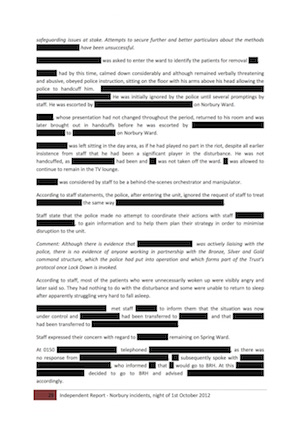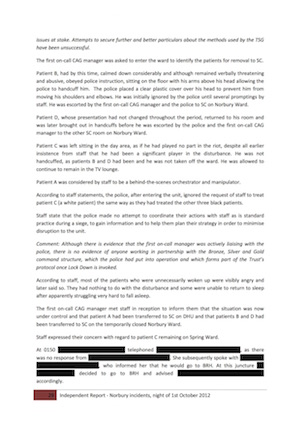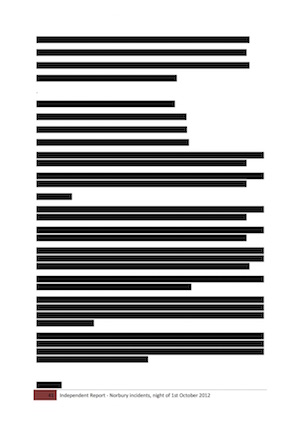
The South London and Maudsley NHS Foundation Trust (SLaM) has attempted to cover up what happened during two related incidents on a mental health ward. On the night of 2012–10–01, at its River House facility, 48 Metropolitan Police Service (MPS) officers were deployed, including officers from armed and dog units, and four Territorial Support Group (TSG) officers drew their Tasers on the mental health ward. The police cannot find its own investigation report. SLaM has eventually published a version of its investigation report with many fewer redactions remaining, in response to my multiple freedom of information requests and an eventual decision notice of the Information Commissioner’s Office.
You can now find out much of what they didn’t want you to know.
The mostly underacted 105-page report, released on 2015–02–25 is available here (in case this redacted report is updated or removed, a copy, as originally published, is available here). For comparison, the extensively redacted version, released on 2014–05–28, is available here (and a safe copy of it, here)


p. 29 in the 2014 and 2015 versions of the report.
What follows are excerpts from the SLaM investigation report which were blacked out in the earlier more extensively redacted release.
‘Three patients (patients A, B, and D; all black) out of the four patients involved were placed in SC [Supervised Confinement]. The fourth patient, (patient C; a white patient), was initially left on the ward, despite concerns raised by staff that this could lead to further disturbance.’ p. 11 (first incident)
‘Incident 2: followed on almost immediately from the first incident, when patient E (a black patient) approached staff demanding an explanation as to why patient C had remained on the Ward. Patient E believed that there was a racial motive which led to staff assisting the police to place three black patients in supervised confinement, whilst a white patient was treated more favourably.’ p. 11 (Emphasis added)
’The UC confirmed that patients A, B, C, and D were involved and that prominent amongst these patients was patient C [a white patient].’ p. 24
’Patient B [a black patient], had by this time, calmed down considerably and although remained verbally threatening and abusive, obeyed police instruction, sitting on the floor with his arms above his head allowing the police to handcuff him. The police placed a clear plastic cover over his head to prevent him from moving his shoulders and elbows. He was initially ignored by the police until several promptings by staff. He was escorted by the first on-call CAG [Clinical Academic Group] manager and the police to SC on Norbury Ward.
Patient C [a white patient] was left sitting in the day area, as if he had played no part in the riot, despite all earlier insistence from staff that he had been a significant player in the disturbance. He was not handcuffed, as patients B and D had been and he was not taken off the ward. He was allowed to continue to remain in the TV lounge.
Patient A was considered by staff to be a behind-the-scenes orchestrator and manipulator.
According to staff statements, the police, after entering the unit, ignored the request of staff to treat patient C (a white patient) the same way as they had treated the other three black patients.’ p. 29 (Emphasis added)
‘Just before the police finally retired staff complained again about patient C [a white patient] remaining on Spring Ward. Therefore, a decision was taken to nurse patient C in the ICA on Spring Ward and to offer him prn medication. Two staff were were deployed on 2:1 observations with this patient.’ p. 30
‘These patients asked staff why one of the main activists [sic] (patient C) in the earlier incident, was left on the unit, while three other patients (all black) had been handcuffed and taken off the unit, accusing them of being racist for transferring three black patients into SC and leaving the white patient on the ward. Patient E (a black patient) approached staff around the nursing station demanding an explanation as to why patient C remained on the ward. Notwithstanding explanation from staff, patient E believed there to be a racist motive in the way black patients had been treated, accusing staff of assisting the police.’ p. 31 (Emphasis added)
’At 2347 the incident was considered by xxxxxxxxxxxxxxxxxxxxxxxxxxxxxxx to be “otherwise so dangerous” that Trojan (armed police officers), Dog Units and London Ambulance Service (LAS) were requested.’ p.23
’At 0052 there were in excess of 20 police officers on site; some in standard police uniform and others in tactical wear, carrying Tasers, shields and batons.’ p. 24 (Emphasis added)
’On arrival of Trojan [armed police officers] (unspecified in the police log), tactical advice was given, as per standard practice, with regard to use of fire arms. However, Trojan was stood down, as was the Bromley Borough Response team, as TSG [Territorial Support Group] would take the lead in entering Spring Ward.’ p. 27
’TSG entered Spring Ward from the fire road entrance via the airlock leading to the ICA and to the main ward in “strict compact riot formation (regimented crowd control)” armed with shields, visors, batons and Taser guns. Taser guns were not used.
Comment: According to some statements, patients who were already asleep and who were in no way connected to the disturbance were forced to leave their bedrooms by police officers, even though staff kept signalling to the officers that the real culprits were in the corridor and in the TV lounge.’ p. 28 (Emphasis added)
’Comment: Most patients played no part in the riot. Nevertheless they were forced to leave their rooms (with the exception of patient F who was SC) as part of the tactical intervention made by the TSG. Some patients subsequently reported their sense of distress to xxxxxxxxxxxxxxxxxxxxxxxx but there is nothing recorded in the notes to this effect, even though there were potential safeguarding issues at stake. Attempts to secure further and better particulars about the methods used by the TSG have been unsuccessful.’ pp. 28–29 (Emphasis added)
‘It took eight weeks to secure material from the Metropolitan Police. Requests for further and better particulars have been unsuccessful, despite several reminders on matters which were explored at interview with an Inspector from Bromley Borough Police.’ p. 15
‘Although, according to some evidence, an agreement had been reached with Bromley Police Station that there would be police presence at the point of patient F’s transfer. When this was requested on 29/09/12, it was not forthcoming.’ p. 15
’At 2317 a third call was made to request ‘riot police support’ - CAD 9864. This was recorded on the police log as three patients had started rioting in the first instance and that all thirteen (patients) had now joined in; that suspects had metal poles and were trying to break the windows where the staff had retreated for security and that if the patients broke the windows, the staff would all be killed because patients had committed murder before.
Comment: This account is inaccurate, either because of what the police were told or because it was misconstrued in the translation. Most of the patients were sleeping or at least in their own bedrooms. There were no metal poles involved, although three patients were continually throwing a large metal bin with force at the window of the nursing station.’ p. 22 (Emphasis added.)
‘When the police declared incident 1 to be a Critical Incident’ p. 80
’A decision was taken to prepare oral prn midazolam 10mg as well as to draw up 7.5mg of midazolam for intramuscular injection. This was because the team determined there be to be a likelihood of patient D refusing oral medication. This was based on previous knowledge of him.
Comment: Preparing intramuscular medication at the same time as oral medication falls outside the ideal standard of practice. Whilst the Trust policy does not give guidance on this matter, NMC guidance (Standard 14: Standards for medicines management (NMC 2007)) is clear. However, under the circumstances and on balance, the Independent Team acknowledge that the specific situation required a degree of flexibility and staff initiative. The Independent Team accept that in some circumstances both oral and injectable medicines can be prepared simultaneously but that the injectable form of the medicine should then be stored in a readily accessible place and not handled in front of the patient at the same time that the oral medication is handled.’ p. 17 (Emphasis added)
’patient B smashed the oral medication out of the hand of the UC, spilling all the medication and water on the floor, along with the intramuscular medication, which according to some statements was concealed out of sight when it had been taken as a contingency measure, should patient D refuse oral medication.
Patient B accused the staff of bullying patients.’ p. 18 (Emphasis added)
‘The HCA [Healthcare Assistant] told the Independent team that as the ‘triggers’ associated with incident 1 were known to staff, that arguably, it was possible to foresee what would happen, once a decision was taken to offer patient D prn medication and how patient B would react to this. Patient B is known to object to the use of medication and tends to act as an intermediary between a patient and a staff member, often to try to ‘whip’ the situation up. In the opinion of the HCA, the situation could have been pre-empted and the police should not have been called.’ p.19 (Emphasis added)
‘The UC [Unit Coordinator] advised some staff to withdraw and to assemble in the nursing station for safety, as the situation was getting out of hand.’ p. 18
‘staff retreated to the nursing station’ p.19
‘Patient F remained unsupervised in SC [Supervised Confinement] once staff in the ICA [Intensive Care Area] and the nursing station had been evacuated from the ward. The first on-call CAG manager (a Registered Nurse) saw patient F on two brief occasions, with a police escort, to establish that he was breathing and not in too much distress.’ p. 28 (Emphasis added)
‘According to a statement from an Inspector from the Metropolitan Police, numerous requests were made to ascertain the names of those involved and risk assessment details, but there were no staff on duty able to provide such information, with no contingency plan, other than calling the police for dealing with such a disturbance. There was discrepancy between this statement and the evidence given by the UC.’ p. 21 (Emphasis added)
‘The UC and three other staff retreated to the nursing station to summon help.’ p. 31
’Comment: Given the severity of the situation the presence of an RC [Responsible Clinician] would have been appropriate. There was no senior medical presence for either incident 1 or 2.’ p. 33
’Eight patients, including patient I, deemed very vulnerable, were left without access to any staff or care.’ p. 34 (Emphasis added)
‘Operation Metallah, a joint BRH/RH - Bromley Metropolitan Police protocol, with an operational implementation date of 20/04/13 – document received.’ p. 84
‘Operation Metallah, undertaken with the Bromley Metropolitan Police, in recognition that a new way of working was required to ensure optimal coordination and management of resources and sharing of information when police assistance is required, whilst not directly commissioned as a result of events on the night of 1st October 2012, has been influenced by it.’ p. 85
‘Operation Metallah - Joint Trust/Bromley Metropolitan Police protocol for responding to requests for police assistance at BRH, April 2013’ p. 104
‘Operation Metallah - Joint Trust/Bromley Metropolitan Police protocol for responding to requests for police assistance at BRH, April 2013’ p. 104
‘SC - Supervised confinement (seclusion)’ p. 105
‘Trojan - Metropolitan Police Firearms Unit’ p. 105
‘TSG - Tactical Support Group (Metropolitan Police)’ p. 105
 It would have been useful to get the Metropolitan Police Service (MPS) version of their intervention at River House that night, especially as from SLaM’s investigation report it would appear some TSG officers behaved in a racist way and caused undue distress to several vulnerable patients. An internal MPS email explains that ‘I have been informed that on [sic] Incident Management Log was created however despite searches on [Bromley] borough and with the senior investigating officer I have not been able to locate this document. Furthermore one document refers to a meeting in which this matter was to be discussed , again no further information could be found in respect of this meeting which may or may not have occurred.’ Following a complaint about the loss of this important document, the investigation log at an incident declared to be critical, the Information Commissioner’s Office wrote that ‘I have been advised by the MPS that searches for the log, which would be in hard copy rather than electronic, have failed to locate anything. Senior Officers connected to the event have been contacted but to no avail. The MPS have stated to me: “Unfortunately, in this instance the log in question cannot be located and is therefore, on the balance of probability not held”.’
It would have been useful to get the Metropolitan Police Service (MPS) version of their intervention at River House that night, especially as from SLaM’s investigation report it would appear some TSG officers behaved in a racist way and caused undue distress to several vulnerable patients. An internal MPS email explains that ‘I have been informed that on [sic] Incident Management Log was created however despite searches on [Bromley] borough and with the senior investigating officer I have not been able to locate this document. Furthermore one document refers to a meeting in which this matter was to be discussed , again no further information could be found in respect of this meeting which may or may not have occurred.’ Following a complaint about the loss of this important document, the investigation log at an incident declared to be critical, the Information Commissioner’s Office wrote that ‘I have been advised by the MPS that searches for the log, which would be in hard copy rather than electronic, have failed to locate anything. Senior Officers connected to the event have been contacted but to no avail. The MPS have stated to me: “Unfortunately, in this instance the log in question cannot be located and is therefore, on the balance of probability not held”.’
So far, it has taken eleven freedom of information requests (to SLaM, the MPS, the Independent Police Complaint Commission, the Care Quality Commission and to Monitor), too many complaints to the Information Commissioner’s Office and a decision notice to uncover what has just been exposed that the South London and Maudsley NHS Foundation Trust and the police didn’t want us to know.
Some of these revelations are shocking.
There are still some redactions, which are likely unwarranted and, if so, in breach of the the decision notice of the Information Commissioner’s Office. The only valid exemption, agreed by the Information Commissioner’s Office, is for third party personal data which explains that most names are still redacted. It is more difficult to understand how the use of this exemption can be justified to miss pp. 39–67 from the table of content (on p. 2), and that from the middle of p. 40 to the middle of p. 65 the content is still entirely blacked out. From the headings just before and after these redactions, the redacted text must concern some of the findings of the investigation.
[Update 2015-04-24] The Information Commissioner’s Office has now compared the redactions made by SLaM with the steps prescribed in the decision notice and concludes:
‘From my analysis of the redacted and unredacted versions of the report, I am satisfied that SLAM has generally acted in accordance with the Commissioner’s instructions and therefore complied with the decision notice. This finding also applies to SLAM’s decision to withhold pages 40 – 65 in their entirety.’
Here are my previous posts about this incident:
And also some of the internal SLaM correspondence and internal MPS correspondence about my earlier FoI requests.
First published on 2015-04-06; last updated on 2015-06-24 to add details about compliance of remaining redactions.